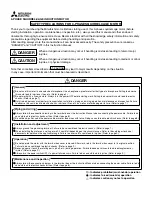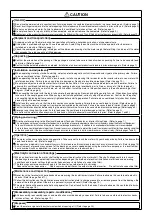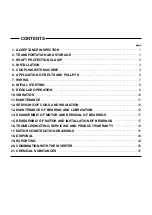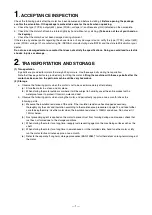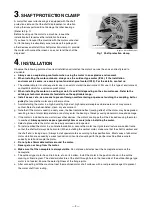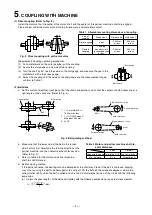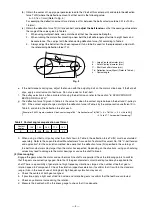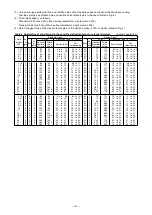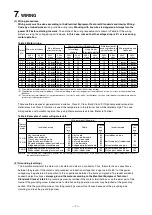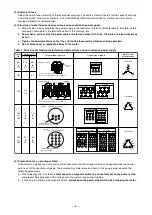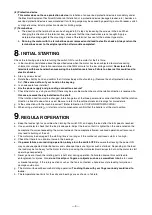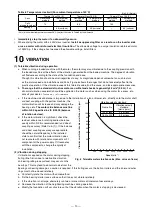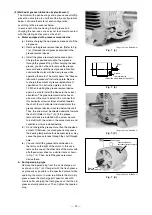
CAUTION
[General]
Do not use the motor outside its specifications. Failure to observe this could lead to electric shocks, injuries or damage, etc. (Refer to page 1.)
Do not insert fingers or objects into the motor openings. Failure to observe this could lead to electric shocks, injuries or fires, etc. (Refer to page 9.)
Do not use a damaged motor. Failure to observe this could lead to injuries or fires, etc. (Refer to page 1.)
Do not place items to impair visibility of the nameplate, and do not remove the nameplate. (Refer to page 2.)
Modifications of the product by the user are not covered by the Mitsubishi Warranty. Thus, Mitsubishi will not bear any responsibility. (Refer to page 19.)
[Shipment and transportation]
Dropping or failing of the motor during transportation will create a hazardous situation, so take special care.
If the motor is provided with eye bolts, use the eye bolts. Avoid lifting the entire machine with the eye bolts after the motor is
installed on a machine. (Refer to page 1.)
Check the nameplate, packaging, catalog or outline dimension drawings for the motor weight before lifting it, and do not lift a motor
that exceeds the rated capacity of lifting devices.
[Unpacking]
Confirm the orientation of the package. If the package is crated, take care to the nails when unpacking. Failure to do so could lead
to injuries. (Refer to page 1.)
Confirm that the delivered product is as ordered. Installation of an incorrect product could lead to injuries or damage etc. (Refer to page 1.)
[Installation and adjustment]
When operating motor by star-delta starting, select an electromagnetic switch (three-conductor type) on the primary side. Failure
to do so could lead to fires. (Refer to page 8.)
When operating the motor with a 400V class inverter, install a suppressing filter or reactor on the inverter side, or use a motor with
reinforced insulation. Failure to do so could lead to damage or fires due to insulation breakage. (Refer to page 10.)
Do not place objects around the motor that will block the ventilation. Do not place flammable objects around the motor. Failure to
observe this could lead to blocking of the cooling leading to abnormal overheating, or to firers or burns, etc. (Refer to page 2.)
The outdoor type motor has a drain hole, etc. on its bottom. Install the motor in the position shown in the outline drawing or final
diagram. (Refer to page 2.)
When coupling the motor with the load, take care to the centering, belt tension and pulley parallelism, etc. When directly coupling,
take care to the coupling precision. When using a belt catching method, correctly adjust the belt tension. Confirm that the pulley
and coupling tightening bolts are securely tightened before starting operation. Failure to do so could lead to injuries from broken
pieces flying or to device damage.
Install a safety cover, etc., so that the rotary sections cannot be touched. Failure to do so could lead to injuries. (Refer to page 2.)
When running the motor as a single unit, remove the key installed on the shaft-end. Failure to do so could lead to injuries. (Refer to page 9.)
Confirm the rotation direction before coupling the motor with machine. Failure to do so could lead to machine damage. (Refer to page 9.)
Never get on or hang from the motor. Failure to observe this could lead to motor damage or injuries. (Refer to page 2.)
Do not touch the motor shaft end keyway with bare hands. Failure to observe this could lead to injuries. (Refer to pages 1 and 9.)
[Piping and wiring]
Wire the motor according to the Electrical Equipment Technical Standards or Interior Wiring Code. (Refer to page 7.)
This motor does not have a circuit protection device. Installation of an overload protection device is mandatory under the Electrical Equipment
Technical Standards. Installation of a protection device (leakage breaker, etc.) in addition to an overload protection device is recommended.
Failure to do so could lead to burning or fires. General fuses may not be able to protect the motor from overcurrent. Monitor the operating condition
of the fuse used, and, if the fuse cannot operate upon occurrence of trouble, install a motor breaker or a thermal relay. (Refer to pages 7 and 9.)
[Operation]
The motor will become quite hot during operation. Take care not to touch the motor with your hands or body. Failure to observe this
could lead to burns, etc. (Refer to page 9.)
Stop operation immediately if an abnormality occurs. Failure to observe this could lead to electric shocks, injuries or fires, etc. (Refer to page 10.)
A small amount of grease may come out of the bearings, so care is needed when using the motor for a purpose or in a location that
has to avoid oil (such as operation in a clean room or operation on a food machine).
[Electrolytic corrosion of bearings]
When an inverter drives the motor, shaft voltage occurs theoretically on the motor shaft. The shaft voltage could rarely cause
the bearings to experience electrolytic corrosion depending on the method of electrical installation, motor load and operating
conditions and inverter settings (high carrier frequencies or installation of a capacitive filter).
The following countermeasures may apply to the inverter to avoid electrolytic corrosion.
· Reduce the carrier frequencies. · Add a common mode filter on the output side of the inverter. · Do not install a capacitive filter.
[Maintenance and inspection]
Never touch the terminal with bare hands when measuring the insulation resistance. Failure to observe this could lead to electric
shocks. (Refer to page 9 and 11.)
Follow the instructions on the lubrication procedure instruction plate to charge grease into or remove grease from the bearings. Be
aware of the rotating bodies. Otherwise, a personal injury could result. (Refer to page 13.)
The motor frame will become quite hot during operation. Do not touch it with the hands. Failure to observe this could lead to burns,
etc. (Refer to page 18.)
[Disassembly, reassembly, repairs, modification]
All disassembly, reassembly, repairs and modification must be done by a specialist. Failure to do so could lead to electric shocks,
injuries or fires, etc. (Refer to page 19.)
[Disposal]
Treat the motor as general industrial waste when disposing of it. (Refer to page 24.)



